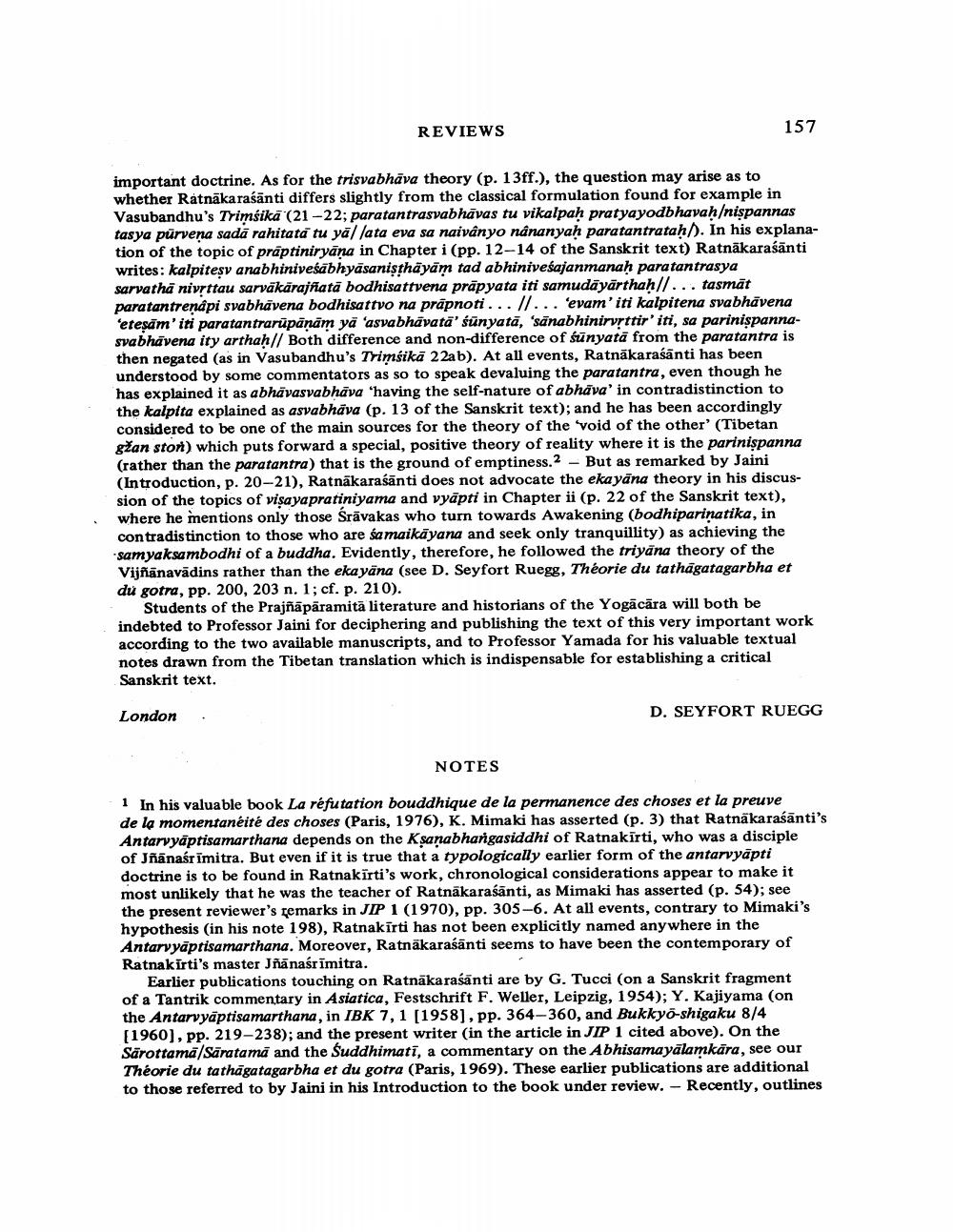________________
REVIEWS
157
important doctrine. As for the trisvabhāva theory (p. 13ff.), the question may arise as to whether Ratnakaraśānti differs slightly from the classical formulation found for example in Vasubandhu's Trimśikā (21-22; paratantrasvabhāvas tu vikalpah pratyayodbhavah/nispannas tasya pürvena sada rahitata tu yallata eva sa naivânyo nananyah paratantratah/). In his explanation of the topic of praptiniryāna in Chapter i (pp. 12-14 of the Sanskrit text) Ratnākaraśānti writes: kalpiteşv anabhiniveśabhyāsanisthāyām tad abhiniveśajanmanah paratantrasya sarvatha nivrttau sarvākārajñatā bodhisattvena prāpyata iti samudāyārthah// ... tasmāt paratantrenápi svabhāvena bodhisattvo na prāpnoti...//... 'evam'iti kalpitena svabhāvena 'etesām'iti paratantrarūpānām yā 'asvabhavata' śünyată, 'sanabhinirvrttir'iti, sa parinispannasvabhāvena ity arthah// Both difference and non-difference of śünyata from the paratantra is then negated (as in Vasubandhu's Trimśikā 22ab). At all events, Ratnakaraśānti has been understood by some commentators as so to speak devaluing the paratantra, even though he has explained it as abhävasvabhāva 'having the self-nature of abhāva' in contradistinction to the kalpita explained as asvabhäva (p. 13 of the Sanskrit text); and he has been accordingly considered to be one of the main sources for the theory of the void of the other' (Tibetan gžan stort) which puts forward a special, positive theory of reality where it is the parinispanna (rather than the paratantra) that is the ground of emptiness.2 – But as remarked by Jaini (Introduction, p. 20-21), Ratnākaraśānti does not advocate the ekayāna theory in his discussion of the topics of visayapratiniyama and vyāpti in Chapter ii (p. 22 of the Sanskrit text), where he mentions only those Srāvakas who turn towards Awakening (bodhiparinatika, in contradistinction to those who are sa maikāyana and seek only tranquillity) as achieving the samyaksambodhi of a buddha. Evidently, therefore, he followed the triyana theory of the Vijñānavādins rather than the ekayāna (see D. Seyfort Ruegg, Théorie du tathāgatagarbha et du gotra, pp. 200, 203 n. 1; cf. p. 210).
Students of the Prajñāpāramitā literature and historians of the Yogācāra will both be indebted to Professor Jaini for deciphering and publishing the text of this very important work according to the two available manuscripts, and to Professor Yamada for his valuable textual notes drawn from the Tibetan translation which is indispensable for establishing a critical Sanskrit text.
London
D. SEYFORT RUEGG
NOTES
1 In his valuable book La réfutation bouddhique de la permanence des choses et la preuve de la momentanéité des choses (Paris, 1976), K. Mimaki has asserted (p. 3) that Ratnakaraśānti's Antarvyāptisamarthana depends on the K sanabhangasiddhi of Ratnakīrti, who was a disciple of Jñanaśr imitra. But even if it is true that a typologically earlier form of the antarvyāpti doctrine is to be found in Ratnakirti's work, chronological considerations appear to make it most unlikely that he was the teacher of Ratnakaraśānti, as Mimaki has asserted (p. 54); see the present reviewer's remarks in JIP 1 (1970), pp. 305-6. At all events, contrary to Mimaki's hypothesis (in his note 198), Ratnakirti has not been explicitly named anywhere in the Antarvyāptisamarthana. Moreover, Ratnakaraśānti seems to have been the contemporary of Ratnakirti's master Jñanaśrīmitra.
Earlier publications touching on Ratnakaraśānti are by G. Tucci (on a Sanskrit fragment of a Tantrik commentary in Asiatica, Festschrift F. Weller, Leipzig, 1954); Y. Kajiyama (on the Antarvyāptisamarthana, in IBK 7,1 [1958], pp. 364-360, and Bukkyo-shigaku 8/4 (1960), pp. 219-238); and the present writer (in the article in JIP 1 cited above). On the Sārottama/Säratama and the Suddhimati, a commentary on the Abhisamayalamkāra, see our Théorie du tathāgatagarbha et du gotra (Paris, 1969). These earlier publications are additional to those referred to by Jaini in his Introduction to the book under review. - Recently, outlines




